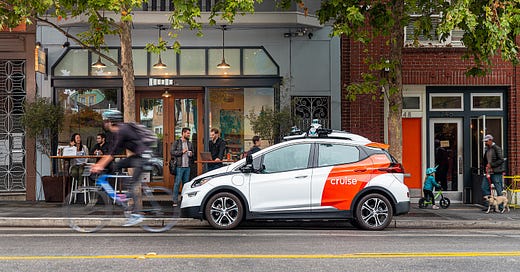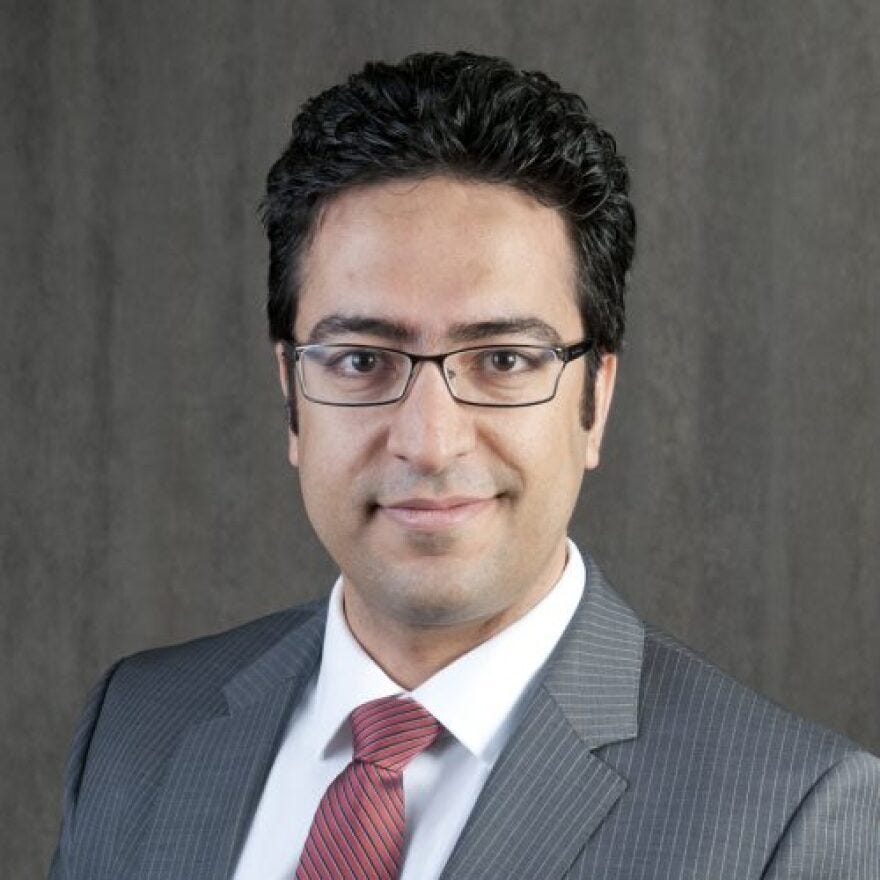Driverless cars might actually slow traffic
Self-driving vehicles were tested in Charlotte — what will happen when the technology improves?
You’re reading Transit Time, a weekly newsletter for Charlotte people who leave the house. Cars, buses, light rail, bikes, scooters … if you use it to get around the city, we write about it. Transit Time is produced in partnership between The Charlotte Ledger and WFAE.
Transit Time is the media partner of the 2023 South Charlotte Partners Regional Transportation Summit — a gathering on Sept. 11 at The Ballantyne hotel that brings together federal, state and local policymakers to discuss trends in transportation and mobility. Find out more and get tickets here
An N.C. State professor studying self-driving cars makes the surprising conclusion that they will cause more congestion than human-driven vehicles
The driverless cab company Cruise has been offering rides to passengers in San Francisco. It tested its vehicles in Charlotte this month, but with drivers behind the wheel. (Photo courtesy of Cruise)
by Ely Portillo
Even though they always seem to be just a few years away, it’s become an item of orthodoxy that driverless cars will help relieve congestion, doing away with snarled traffic, long lines of inefficiently distributed cars clogging popular routes and rush hour fender-benders caused by drivers texting away.
But what if the opposite is actually true? What if taking drivers out of the equation actually makes traffic worse?
That’s the conclusion of a new study from N.C. State University professor Ali Hajbabaie. He discussed the findings and implications with WFAE Morning Edition host Marshall Terry this week, and you can listen to their conversation here.
(We also have a transcript below.)
You can read Hajbabaie’s original study here. (Though it’s paywalled, some local schools and institutions have access that you can use to log in.) As Charlotte sees its first on-street self-driving car tests — autonomous cab company Cruise tested its taxis here last week, though with a human driver behind the wheel as well — the question of autonomous vehicles and traffic is becoming less science fiction, more real policy consideration.
Here’s the short version. Hajbabaie studied four different combinations of vehicles fleets:
fully non-autonomous (human-driven)
fully autonomous
connected vehicles
connected autonomous vehicles
Connected autonomous vehicles are those that not only drive themselves but also communicate with each other and traffic signals (For example, a car approaching a red light can announce itself. The light can turn green if there’s no cross traffic, allowing the car to pass without waiting.)
Hajbabaie concluded that out of those four vehicle fleet combinations, the fully autonomous would actually be the slowest and contribute the most to traffic congestion. That’s because autonomous vehicles, which are still objects of curiosity in most places, have to be programmed to drive more conservatively than humans generally do. Think longer following distances, slowing down well in advance of yellow lights, driving at the speed limit. All of those actually sound like good ideas, but they’ll likely slow down traffic.
So while it’s possible autonomous vehicles might make our roads safer (though there’s plenty of skepticism on that front too), they won’t necessarily be faster. As reckless as humans operating cars can be, we’re apparently faster than a fleet of robocars at getting from Point A to Point B.
The good news? Hajbabaie found that a fleet of connected autonomous vehicles would be faster than its human-driven equivalent. Once self-driving cars can talk to each other, they won’t have to be quite so conservative in their driving habits. And cars that can run closer together, communicate with traffic lights and figure out the most efficient way to get from place to place will help with traffic.
So when it comes to managing traffic, it’s not the autonomy of cars that matters most, Hajbabaie argues, but their connectivity.
Read the whole conversation for more:
Marshall Terry: We'll get into your research and what you found in just a moment. But first, can you explain generally how these self-driving cars work?
Ali Hajbabaie: There are a few components in self-driving cars that essentially allow them to drive on our streets.
One thing is perception. So, these cars are equipped with sensors so that they can see and perceive the environment — other cars, lane markings, traffic control signs, pedestrians and so forth.
And then there are algorithms inside the cars that are going to help the car come up with passes to go through the road while they are seeing the car, so that algorithm is gonna come up with several trajectories, that's what we call them, and the car is going to select the best [trajectory] to proceed through an intersection, through an arterial street and other facilities.
Ali Hajbabaie is an associate professor in the Department of Civil, Construction and Environmental Engineering at N.C. State. (Photo courtesy of N.C. State University)
Terry: Now getting into your research, you mentioned vehicles that are connected and those that are not connected. What's the distinction there, and what effect do they have on traffic?
Hajbabaie: So, connectivity is technology that allows cars to communicate with other cars, with traffic control devices and also with other system users, such as pedestrians.
Now, if a car is able to communicate with the computer that controls the traffic light, the car can have a better idea about what traffic lights are going to be shown up in the near future and based on that, the car can plan its arrival to the intersection so that it does not have to stop or it can go through the intersection with minor disruptions to the speed. And as a result of that, the travel time could be reduced [and] the number of stops could be reduced, so the efficiency is going to go up and at the same time, the emissions are going to be reduced.
So, connected vehicles, we have found that they can increase the capacity at signalized intersections so that we can have smoother travel through the intersections. Now, if we have a vehicle that is autonomous but not connected, the story is going to be different.
Terry: And why is that?
Hajbabaie: Well, autonomous vehicles now are programmed to be more cautious than human drivers so that we can increase safety or at least maintain the same level of safety.
So, the effect of that is that when they get to an intersection, they are going to reduce their speed a little bit sooner than us. When they see a green light, they have to be more cautious in speeding up. They have to maintain larger gaps with the vehicle in front of them.
As a result of that, what we have seen in our computer-based simulations is that they reduce the capacity, and what that does is that we are going to see longer lines of vehicle at signalized intersections. We’re going to have longer travel time, and that’s something that we hope we don’t see, but it’s happening as of now.
Terry: One interesting finding in your paper was that the biggest reduction in road capacity and increase in traffic actually happened with a fleet of 100% autonomous vehicles. That seems counterintuitive.
Hajbabaie: Yeah. If all of the vehicles — 100% of the fleet, only autonomous, do not talk to each other — you have a fleet of cars that are super cautious. And as a result of that, we are going to have up to 20% reduction in the capacity. Now, that is the way that we have programmed autonomous cars as of now and as the technology matures, this programming can change, and they may end up maintaining shorter distances between them and as a result of that, the capacity can go up.
But now, if you have 100% connected and autonomous vehicles, these are cars that are driven by computers, and they can communicate with each other and with traffic light controllers. Then what we have observed is that the capacity could be increased by 80%, which is a huge increase in the capacity. It will reduce our travel time significantly and also the emissions at intersections.
Terry: Even if self-driving cars don't always make streets faster, could they still make them safer?
Hajbabaie: Well, that’s the objective — and if you compare the safety to human-driven vehicles, the technology suggests that they would be able to make our streets safer.
Terry: Just because they're more cautious than we are?
Hajbabaie: They are more cautious than we are. They can do thousands and thousands of calculations in finding the best way to go forward, and they are much faster than us in reacting to something that is going to happen.
As a driver, for example, we are trained not to be that worried about the car behind us, but an autonomous vehicle can observe the cars also that are approaching from [the] back. As a result of more observability and also being able to react much faster than us, they hopefully would improve safety in our streets.
Terry: So what’s the takeaway from all of this for consumers and also for city leaders in places like Charlotte where this technology could soon roll out?
Hajbabaie: I think one main takeaway is the effects of connectivity on traffic operations here.
When we have connected vehicles, we have already observed that the capacity is improving, travel time is reducing, emissions are reducing — and as a result of that, cities [and] state [transportation departments], if they provide hardware to signalize intersections so that they can communicate with cars that are equipped with wireless systems and share information, I think that would significantly help our traffic in signalized intersections and perhaps in other highway facilities as well.
—
Ely Portillo is senior editor for news and planning at WFAE, Charlotte’s NPR news source. He was previously with the UNC Charlotte Urban Institute and spent a decade as a reporter at The Charlotte Observer. Reach him at eportillo@wfae.org
Transit Time is a production of The Charlotte Ledger and WFAE. You can adjust your newsletter preferences on the ‘My Account’ page.
Did somebody forward you this newsletter and you need to sign up? You can do that here:
Other affiliated Charlotte newsletters and podcasts that might interest you:
The Charlotte Ledger Business Newsletter, Ways of Life newsletter (obituaries) and Fútbol Friday (Charlotte FC), available from The Charlotte Ledger.
The Inside Politics newsletter, available from WFAE.








